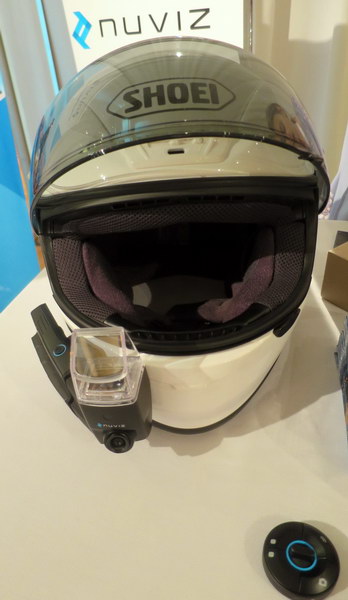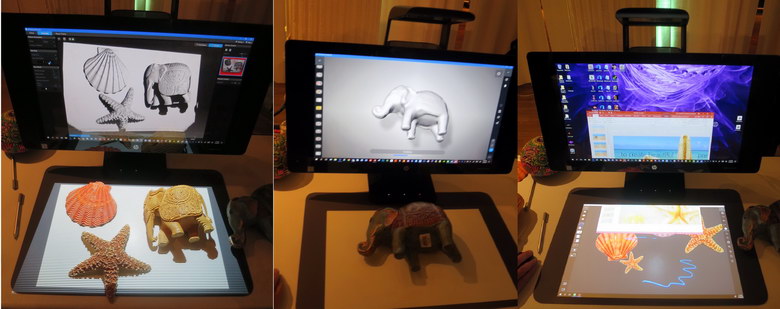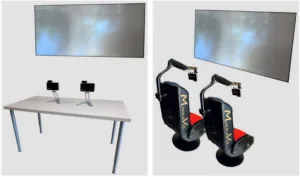CES Unveiled New York was held by the Consumer Technology Association (CTA), owners of CES, on November 9, 2017. The talks discussing the upcoming CES 2018 in Las Vegas were covered in my Display Daily, CES Unveiled: Get Ready for Las Vegas. There was also a small technology exhibition with 24 exhibitors plus a display case showing some, but not all of the products that have won a CES 2018 Innovation Award. While the exhibition was small, several of these exhibitors and awardees were display-related and of interest to LDM/MDM readers.
 Nuviz HMD mounted on a motorcycle helmet. The controller, which would normally be mounted on the handlebars, is visible at the bottom. (Credit: M. Brennesholtz)
Nuviz HMD mounted on a motorcycle helmet. The controller, which would normally be mounted on the handlebars, is visible at the bottom. (Credit: M. Brennesholtz)
Nuviz was there with their motorcycle head up display that mounted on the motorcycle rider’s helmet. This was covered extensively by Art Berman’s Display Daily published shortly after it was announced. All I can add to that is the unit is shipping now and the display is based on a Himax LCoS chip. This Android see-through AR system can also act like a smart-watch and relay incoming phone calls and text messages to the motorcycle rider, hopefully without distracting him from controlling his motorcycle. This unit was a product selected by the CTA for an Innovation Award at CES 2018 and was on display in with the other Innovation awards, as well as being shown in a booth.
MirraViz Table Top (Left) and Gaming Chair systems. (Credit MirraViz)
MirraViz was there with their projection screen that allows two or more different people view different content on the same projection screen (MirraViz Offers Multiple Content Shown on One Projector Screen at the Same Time). Essentially, this screen is a retroreflective surface that sends the light from a projector back in the same direction as it came from. From a projection point of view, this approach has several advantages.
First, of course, it allows two different projectors to share the same screen, just as MirraViz says. Second, the retroreflective surface acts as a very high gain screen, providing large, bright images from relatively low lumen output pico and micro projectors. Finally, the high gain acts as a contrast enhancing screen that will provide high contrast images with relatively high ambient light, as long as the light source isn’t directly behind the viewer. The down-side of the system is the projector must be located quite close to the viewer’s head. Head-mounted pico projector, anybody? The table top system comes in 80” ($2,299) and 97” ($2,799) screen sizes and includes the screen, two picoprojectors and two projector stands. The microprojectors are 720P, 500 lumens and have a 1.5 hour battery life. The gaming chair system, including two chairs, two projectors and a screen, is $3,499 with the 80” screen or $3999 with the 97” screen.
 Light Labs L16 Camera. Left: The L16 in the Innovation Awards display at CES Unveiled New York with the multiple camera apertures just barely visible behind the Gorilla Glass cover plate. (Credit: M. Brennesholtz) Right: An exploded view of the L16. The version of this on the Light Labs website is interactive and gives a brief explanation of each component. (Credit: Light Labs)
Light Labs L16 Camera. Left: The L16 in the Innovation Awards display at CES Unveiled New York with the multiple camera apertures just barely visible behind the Gorilla Glass cover plate. (Credit: M. Brennesholtz) Right: An exploded view of the L16. The version of this on the Light Labs website is interactive and gives a brief explanation of each component. (Credit: Light Labs)
My last Display Daily was on ultra-thin cameras based on computational photography. The L16 Camera from Light Labs is the first commercially (almost) available camera I have seen that is based on computational photography. It doesn’t use the technologies I described, but there are many approaches to computational photography.
The L16 uses 16 individual 13MP sensors and computational photography techniques to merge the images and produce what is said to be a 35mm SLR-quality image in a package without the giant 35mm lens sticking out the front. It is not ultra-thin, with dimensions of 6.5” x 3.3” x 0.94” (165 x 84.5 x 0.94 x 24.05 mm) and a weight of 15.3 oz. (435 g). The internal Qualcomm Snapdragon 820 processor working with the Light Labs ASIC will produce a 13MP image for immediate sharing. To produce the full 35mm quality image, the data must be downloaded to a Windows or Mac PC for processing.
The camera has GPS, Wi-Fi and Bluetooth connectivity plus USB for charging and transferring files. The L16 has a 4120mAh lithium-ion polymer battery said to be good for up to 8 hours of life. In addition to still images, Light Labs says that 4K video is “coming soon.” Unfortunately, the L16 was in the CTA Innovation Awards display case behind glass and there was no representative from Light Labs to explain or demonstrate the camera. The L16 is expected to ship in early 2018 and the company is taking reservations at a total price of $1950, with a $250 deposit and $1700 due on delivery.
 HP’s Sprout Pro 3D Imaging workstation. Left: Generating 3D models with structured light. Center: Generating a 3D model with imaging techniques. Right: Using the LCD and the projector as a dual-monitor Windows system.
HP’s Sprout Pro 3D Imaging workstation. Left: Generating 3D models with structured light. Center: Generating a 3D model with imaging techniques. Right: Using the LCD and the projector as a dual-monitor Windows system.
HP Inc. was there demonstrating its Sprout Pro 3D Imaging Workstation. They were showing the second generation system (CES 2017 Round-Up) and I got a complete tour of it from Brad Short, the inventor of the technology at HP. The Sprout Pro system is an integrated Windows 10 computer that includes two displays, a 23.8″ 1920 x 1080 direct view LCD with 10-point touch and a 1920 x 1080 projector that shows a 23.8″ image on the Touch Mat integrated with the system. The Touch Mat is 2.2mm thick and has a 20-point capacitive touch system. The Touch Mat is also pressure sensitive, with 2048 levels of sensitivity. There is also a 14MP camera that looks at the Touch Mat.
The main application of the system is to generate full color, 3D computer models that can then be used by other software. Short said popular applications of these 3D models are in animation, including generating VR and gaming content, and in educational applications.
The Sprout Pro system can generate 3D models two ways. First, it can use structured light from the projector to generate models with high depth accuracy. Alternatively, it can use a technique Short called imaging 3D that just calls for the user to rotate the object in the field of view of the camera until it has acquired the entire surface of the object. In this mode, the projector just supplies uniform white light to illuminate the system. The LCD monitor showed which parts of the object had not yet been mapped so the user could rotate the object to map them. This results in a lower accuracy 3D model but, with the color data added to the model, is sufficient for most applications. According to Short, the 3D models developed by the Sprout Pro system are fully compatible with Sketchfab, an on-line space much like YouTube only for sharing 3D images. The Sprout Pro system is available now from HP at a price of about $3700, depending on the computer options chosen. –Matthew Brennesholtz

